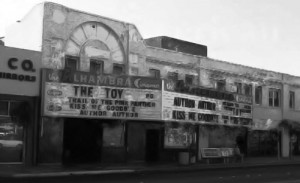The theatre industry has long been rather “creative” with it’s own history; especially when it comes to who was first to reach a specific milestone. Be it the result of exhibitors attempting to “one up” each other or simply classic showmanship, there are usually numerous parties holding claim to the same industry breakthrough. One such multi storied first is found with the multiplex concept.
.
Perhaps, the most well publicized multi screen pioneer was AMC’s Stan Durwood. Often referred to as the “father of the multiplex”, Durwood opened his first multi screen theatre in 1963, via Kansas City’s Parkway Twin; company folklore stating that the idea came to him a year earlier, while standing in the empty lobby of the Roxy theatre (realizing that multiple auditoriums would provide a more advantageous business model). Mr. Durwood would go on to refine and popularize the concept over the ensuing three decades, eventually pushing venue screen counts to their late 90’s megaplex peak. However, despite his name being forever linked with the concept (even headlining his obituary), Stan Durwood was more modern multiplex innovator than inventor.
The commonly cited inventor of the multi screen theatre is Canada’s Nat Taylor, who twined the Elgin Theatre on December 31, 1947 (the 800 seat Elgin and 350 seat Little Elgin). Initially, showing the same feature on both screens, the Elgin would eventually screen two separate features, which many consider to be the true birth of multi screen theatres (the key difference being multiple features screening in the venue). The Elgin would last until 1994 and Taylor would go on to co found Cineplex Odeon, a company that would set several screen count milestones and temporary records over the years.
.
A lesser known early multiplex pioneer was a name that would go on to become rather well known in Southern California, James Edwards. Long before Edwards carved out a monopoly in the greater Orange County area, he was a successful theatre operator in Los Angeles. Among his cinema holdings at the time was the 900 seat Alhambra Theatre, which he twinned in 1937; through purchasing a neighboring storefront and converting the space in to the smaller, Alhambra Annex. As with other multi screen theatres that emerged in the 1940’s, the complex initially screened a single feature title in both auditoriums; one screen showing a double bill (feature teamed with a lesser film), while the smaller screen ran the feature as a stand alone. While predating most other claims to being the “first”, Edwards’ multi has often been overlooked, due to it’s later conversion to more than one feature being shown. None the less, the Alhambra stood as one of the earliest multi screen theatres, until earthquake damage forced the cinema’s demolition in the late 80’s.
.
Ultimately, the “inventor” of the multiplex concept depends on one’s definition of a multiplex (more than one screen verses more than three, whether the number of screens or films is the defining factor, etc.) and which particular exhibitor’s story has managed to gain the wider degree of acceptance at any given time. In addition to the three named previously there are numerous other theatres and individuals that lay claim to the title. In the end, we are left with a novel idea, that has been developed and exploited (for better or worse), by numerous individuals over the past seven plus decades.
Tags: 1 Comment





1 response so far ↓
there is a video about Nat Taylor and his Elgin theatre in Ottawa at
http://www.histori.ca/minutes/minute.do?id=10229
En Français: http://www.histori.ca/minutes/minute.do?id=10486